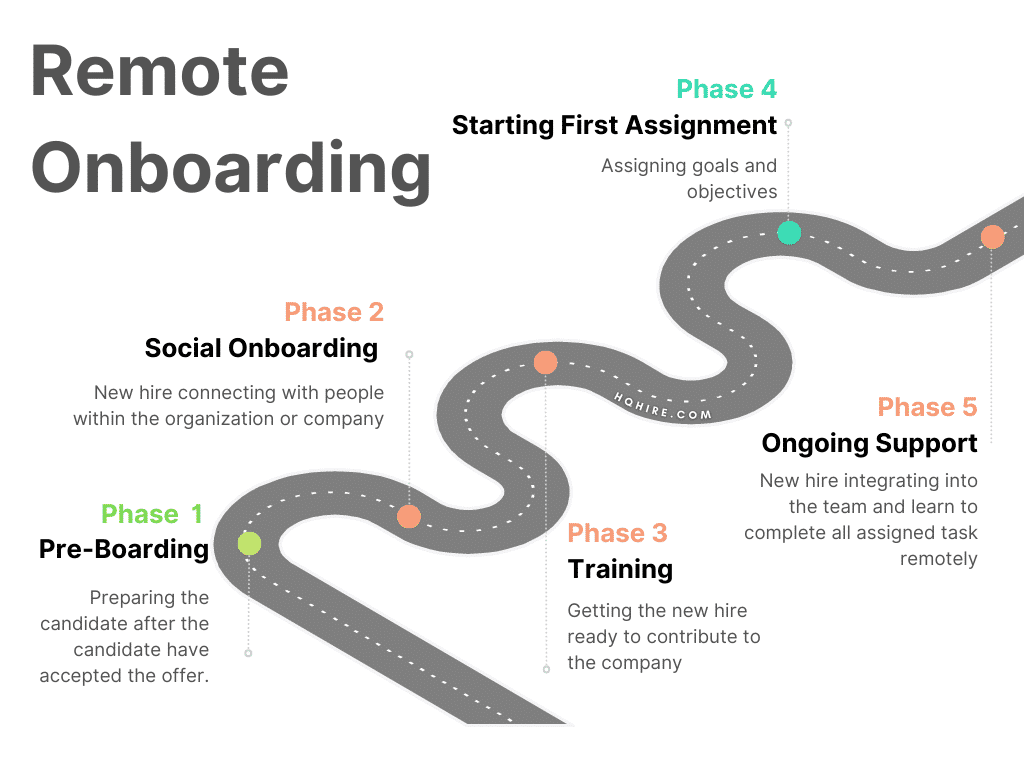Getting a new employee on board can be a daunting task, but there are a few fun and easy ways to make the transition into a new job a little bit easier.
With remote working becoming more common, it’s important to know how to make virtual or remote onboarding both enjoyable and stimulating.
Having an onboarding checklist prepared with some fun remote onboarding ideas, you’ll help them feel at ease and get started on the job right away!
Fun and Creative Remote Onboarding Ideas for New Hires
Remote onboarding of new hires can be fun and engaging. There are many fun ways to onboard a new remote working employee. This includes providing a welcome package, hosting a virtual happy hour, partnering them up with a buddy, and organizing small fun activities such as having a themed Zoom background competition.
As the new hire progress through the 5 phases of remote onboarding, here is the best fun remote onboarding ideas to help your new employee smoothly become a productive and valued member of the team.
1. Mail them a welcome package
One of the joys in life is getting an unexpected package in the mail. What’s even better is when it’s filled with thoughtful and welcoming gifts from your new employer.
Don’t worry if you can’t deliver the goods in person, there’s nothing wrong with sending them through the post or with a delivery driver.
You don’t have to spend a lot of money, but taking the time to provide a few thoughtful gifts will go a long way to showing (rather than just telling) how much you are looking forward to working together.
Why not include:
- Some company-branded stationery
- Noise-canceling headphones
- Wireless headphones
- A stress ball
- Coffee and tea
- A water bottle
- Business cards
- A laptop privacy screen
- A gift voucher to a local fresh food vendor?
Add in a couple of snacks – sweet and savory – and a personal, handwritten note to complete the package.
2. Hold a virtual welcoming party
You might not be able to schedule a virtual party for the whole company, but it is certainly a good idea to welcome your new colleague with a casual get-together with other members of the team.
You can include some enjoyable team-building activities to fast-track the onboarding process such as team trivia contests, photo-sharing events, and other office-based games.
3. Reflect with ‘mindful Monday’ sessions
Mindfulness matters and ‘mindful Mondays’ is a way of encouraging employees to practice mindfulness in a structured and meaningful way. Being mindful means being present, in the moment, and aware of our physical and emotional state of being without judgment.
In practice, it can involve taking time to think and meditate, focus on breathing, or listen to certain types of music.
When you encourage your colleagues, especially those new to the company, to take an active role in their mental health, they are more likely to recognize when they might be struggling and more willing to ask for help.
4. Buddy-up
Starting a new job can be anxiety-inducing at the best of times, and when you’re working remotely, virtual meetings can quickly lead to exhaustion.
Assigning a mentor is a great way to help lessen the toll. With weekly check-in sessions, the new employee has scheduled time to ask questions and learn about company processes and procedures.
Not only will this benefit the new employee, but their feedback will help you improve and streamline the virtual onboarding process for future employees.
5. Take them on a virtual tour
If your company has remote and on-office workers, providing a virtual tour is a great way to help them create a mental map of the traditional working space.
This is a great opportunity to think outside the box. Why not have different speakers host different sections of the tour, and include personal anecdotes where appropriate?
6. Theme your Zoom backgrounds
There are many small ways in which you can add a personal touch to your remote work interactions. If you spend a lot of time on Zoom, why not change your background as a conversation piece?
By providing a weekly theme for team members to work with, you are creating a safe space where they can let their personalities shine.
Don’t worry if you’re not particularly tech-savvy, there are plenty of tutorials out there to help you.
7. Play office games together
There are many different office games that you can play in a virtual environment to forge bonds, learn to communicate and, most importantly, have fun. Why not try:
Ties that bind
This game helps to forge instant connections between co-workers. The aim is to challenge teammates to find at least one common train with the new team member. Not only will it foster interesting interactions, but you might just find that a colleague shares the same Star Trek passion that you do.
An online scavenger hunt
This is a great way to make learning about the new company fun. With a few weeks to complete the task, get your new employees to answer a series of company-themed questions.
The hunt must be tailored specifically for your company, but you can suggest questions such as:
- Who founded the company and when?
- Who is the current CEO?
- What is your company’s most popular product?
Companies like Scavify provide tailored apps for these types of activities.
Trivia competitions
Hosting a weekly ongoing trivia competition will allow the team members to stretch their competitive muscles while bonding over shared challenges and experiences.
8. Host short virtual coffee breaks
Short coffee breaks are a great way to check-in with your team members and to make new employees feel connected to the rest of the group.
Make sure you include one-on-one meetings with senior team members, as well as less formal chats with the whole team.
9. Provide small-team orientation
In-person and virtual onboarding usually involves orientation in some form. Rather than go through the motions with a large, impersonal orientation, try to limit it to a few new employees at a time. In this setting, they are more likely to remain engaged and absorb more of the essential company information.
10. Engage guest speakers
Inviting a guest speaker to give a remote presentation is great for existing and new employees. A new face is a great way to provide a refreshing perspective and it will let on-boarders feel that their professional growth and career trajectory are important.
11. Invite sharing
Providing a relaxed online space for employees to share their thoughts and experiences is a great way to foster close ties. New employees might find this challenging in the beginning, so it might be worthwhile structuring the interaction with themed sessions to get the ball rolling.
You can even restrict membership from senior employees so that lower-ranked team members feel free to share their feelings.
12. Host 1-on-1 meetings
If your new employees haven’t had the opportunity to meet other team members, organizing face-to-face meetings, either one-on-one or in small groups, provides the space for them to converse in a more intimate and less intimidating session.
As the host, you can suggest topics of conversation or steer the discussion as needed.
13. Reward onboarding participation
The Incentive Research Foundation has found that incentive programs can increase workplace productivity by between 25 and 44%. If you’re willing to offer rewards and perks for participation, you’ll find it easy to keep teams focussed on the task and engaged in the virtual workspace.
The reward doesn’t have to have a monetary value (although gift cards or a voucher to your local café are always a good idea). In fact, you might find that an early finish one Friday per month is the preferred reward for hard work and effective online engagement.
14. Develop a digital member lounge
Your senior employees are a wonderful asset when training new employees. However, new workers might be more relaxed if they have the option of mingling with other employees on a similar level as them.
Why not create a library of useful company resources on Google Docs, Dropbox, or Slack, as well as a restricted chat channel, that new and recently new employees can use?
You can include:
- Employee manuals
- Style guides
- Contact lists
- A directory
- A glossary of company terms
15. An online organizational chart
One of the best ways to help your new employee get settled is to have an up-to-date organizational chart ready to go. Not only will is it a useful reference for them, but it frees up their time to concentrate on forming meaningful relationships with their co-workers rather than memorizing facts.
Just make sure that it is up to date and has the contact details for the Human Relations department in case they have any further questions.
Why Does a Good Onboarding Experience Matter?
Onboarding matters because it can help new employees to integrate into the company. Good onboarding can help create an inviting and friendly work environment which can help the new hire on their new job and adapt to the company’s culture.

Remote onboarding can be extremely efficient and effective by allowing new employees to complete required training and orientation modules from their own computer, at their own pace.
Which allows them to take the time they need to absorb the information without feeling rushed or overwhelmed. This helps the new hire to be better prepared for their new job.
According to the Harvard Business Review, remote workers are often more productive than their office-bound colleagues.
Benefits of Good Remote Onboarding Experience
Providing new hires with a good onboarding experience through fun and engaging remote onboarding ideas can help the new hire in feeling more welcomed and comfortable.
New employees are more likely to:
- Be invested in the company.
- Speak up when there is a problem.
- Contribute meaningfully and creatively to the discussion.
- Thrive in their personal and professional lives.
As a new hire, they can also prepare themselves for the onboarding by understanding the expectation of their new job.
A good remote onboarding experience allows the new hire to be will equip with the skills necessary to overcome any potential challenges that they may face in their new role.
Read Also:
- How to Introduce Yourself at Work on Your First Day (with Examples)
- How to Evaluate a Remote Job Offer (It’s About YOU)
- How to Evaluate a Freelance Job Offer For Freelancer ($$ Don’t Always Matters)
- How to Evaluate a Startup Job Offer (4 Powerful Steps)
- 20 Best Practices For Onboarding Remote Employees (Why & How)
Join over 11,000+ achievers who are committed to achieving their career goals!

![How to Do Online Meeting Follow-Up [+12 Follow-Up Meeting Email Templates] 2 How to Do Online Meeting Follow-Up (Follow-up Email For Online Meeting)](https://hqhire.com/wp-content/uploads/2024/04/Online-Meeting-13.jpg)




